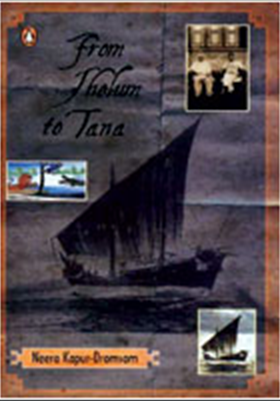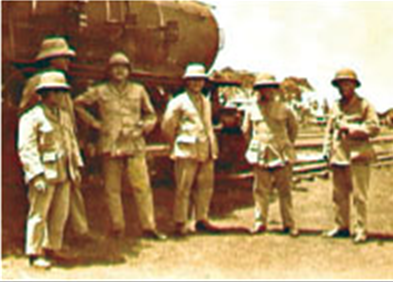Indians in Kenya
This is a collection of articles archived for the excellence of their content. Readers will be able to edit existing articles and post new articles directly |
Contents |
An overview
The Times of India The Times of India 2013/09/24 A centuries-old romance with East Africa
Saeed Khan TNN
Over 75,000 Indian origin people, including passport holders, live in Kenya 75% of them are Kenyan, 10% British overseas and
15% Indian citizens Most are settled around cities like Nairobi and engaged in agriculture and business Old diaspora mainly migrated from Punjab and Gujarat Fresh immigrants belong to places like TN and Andhra and are techies, engineers, teachers etc
Migration to east Africa started in the 19th century and bulk of Indians were taken there to build Mombasa-Kampala railway line and to work in fields
Mostly Gujarati immigrants established retail businesses later and are referred as ‘Dukawallas’
Many Indians left Kenya after they were asked to take work and residence permits under the policy of Kenyanisation of economy in 1967
History
In 1997, the Ugandan president Yowri Museveni asked Gujaratis and other Asians who had fled the country during Idi Amin’s regime to return their African roots. As Uganda tried integrate into the global economy, it needed the famous entrepreneurial zeal of Gujaratis.
Historian Makrand Mehta says, “Gujarati businessmen have played an important role in East Africa’s economic development. As creative emigrants with agift for innovation and entrepreneurship, they were involved in every facet of commercial life until the military regime forced them to leave in the early 1970s.”
Experts say Gujarati migrants of the 19th century are credited with transforming East Africa’s barter society into a money economy. No wonder then that a large number of the Indian victims killed in the terrorist attack at Nairobi’s Westgate mall were Gujaratis. According to one estimate, around 70 of the 300 shops in the mall are owned by Gujaratis. Over 100,000 people of Indian origin live in Kenya at present. Though, Indians constitute less than 1% of the population, they play a key role in the economy.
So well integrated are Indians, especially Gujaratis, in the cultural life of Kenya and Tanzania that there are around 15 Swaminarayan temples in Nairobi, Mombasa, Kerugoya, Kisumu, Nakuru and Eldoret towns. Of the 15-member Kenyan cricket team between 1995 and 2005, seven players had been trained by a club run by the Swaminarayan sect in Nairobi.
Although history shows trade links between Gujarat and the African coast dating back to ancient Babylon, it was in the 1860s that modern day migration started. National Museum of Kenya says that 31,983 workers were taken from India, mainly from Kutch and Punjab, to lay a railway line from Mombasa in Kenya to Kampala in Uganda.
Between 1896 and 1901, 2,493 workers died and 6,454 persons became invalid while laying tracks. But after the contract was over, about 7,000 Indians chose to stay back. Gujaratis started pouring in as free emigrants, and founded their trade and business in Kenya, Tanzania and Uganda. Today, Gujaratis have large land holdings and industrial units.
Philanthropy
Meghji Pethraj Shah, a Gujarati, had setup the hospital named after him where most Nairobi terror attack victims are being treated.
The 94-bed MP Shah Hospital has been treating patients beyond its capacity since terrorists stormed a mall in the city.“We have about 12-15 Gujarati doctors at the hospital,” said Kirtiraben Acharya, who works at the hospital.
Shah, who was from Dabasana village in Jamnagar, owned many businesses and started his career in Kenya. He setup the hospital for Indians in Kenya most of whom are Gujaratis. The hospital is ranked among the best hospitals in Kenya and operates under the umbrella of the Social Service League, a charitable institution.
“He built many hospitals in his hometown besides in Nairobi and a college in his wife’s name in Matunga — Maniben MP Shah Women’s College,’’ said MP Shah Charitable Trust and Foundation trustee Ashok Shah.
In Ahmedabad, he built MP Shah Cancer Hospital, besides a town hall and 40 schools and a medical college in Jamnagar. He built eight hostels in Saurashtra and a college in Surendranagar.
Shah, who ran a tannery and steel business in Kenya, also built an old-age home in his home state. His son, Vipin Shah, is based in London.
Punjabis
Kenya from the Punjab
December 20, 2007
REVIEWS: Tracing roots
Reviewed by Rizwana Naqvi
Memoirs, biographies and travelogues, if written well, make you feel as if you are reliving in the same place and time as described in the book. They not only make for good reading but also take the reader on a journey to far away lands and times.
The same is the case with Neera Kapur-Dromson’s From Jhelum to Tana. The book takes the reader back to the end of the 19th century when people from India went to Africa in large numbers in search of better opportunities.
From Jhelum to Tana is the story of Neera Kapur’s great-grandfather, Kirparam, who sailed to Africa, leaving behind his wife and son, on impulse, not knowing what life had in store for him. In Mombasa he joined the thousands of Indians who were laying lines for the Ugandan Railways commissioned by the British.
The story starts with Hardei, Kirparam’s wife, along with her son, arriving in Nairobi in search of her husband. Reunited, they start life afresh and have more children. Kirparam, with his Indian experience of working at his uncle’s halwa shop, soon becomes a canteen contractor; a dukawala (shop owner) in Nairobi, eventually forming a trading empire that provided employment and prosperity to later generations. He even made voyages to India to hire people for his expanding establishment.
From Jhelum to Tana chronicles not only the life of Kirparam and his family but is also an account of those who left the areas around the bank of Jhelum (that are now in Pakistan) during the late 19th and early 20th century for Kenya in British South Africa, which was then a British protectorate and later became a colony.
In following the saga of Kirparam’s later generations, readers learned about the changing lifestyle of Indians in Kenya, the struggle to maintain their traditions and the challenges they faced to keep up with the times in a far away land.
While the first generation of settlers faced economic hardships and tried to retain their culture and traditions, the second generation spent life amid the upheavals of the Second World War, racial segregation, and the end of colonialism. At the same time they experienced great advancement due to the development of theatre and the magic of cinema. The third and fourth generations moved further ahead and ventured out to other continents — Europe, North America, and Australia — for higher studies and took up new vocations, even new faiths.
The author breaks her narrative from time to time to give detailed accounts of contemporary political and religious situations, such as the sectarian conflict between the Arya Samajis and the Sanatanis, the differing views on observing the rituals of birth and death among Hindus, etc. Dromson also describes the reforms enforced by the British that were accepted with more difficulty by Africans than by Indians. These included the introduction of currency, especially for payment of taxes. The Africans had no concept of money as they depended mostly on the barter system.
The book takes the reader back to the end of the 19th century when people from India went to Africa in large numbers in search of better opportunities.
The book also offers a social history of Kenya as it delves into the political and social situation of the times to reveal how two countries met and interacted with each other.
In the multicultural country that Kenya had become, racial discrimination was quite evident; the conflict lay between Asians and native Africans, as well as between the white and non-white citizens. The racial apartheid was evident from the early days — the British (and other Europeans) had separate areas in the cool highlands while the Indians lived in the plains or the midlands, mostly in Indian bazaars which lacked proper sanitation.
The Indians provided a cheap labour force and were eager to make their profit in trade and shops, catering to the daily needs of the time. They worked day and night to build the country yet lived in abject poverty and pathetic conditions. They were the ones who mourned the death of their children during plagues.
In fact, the most touching parts of the book are those that describe the hardships faced by workers completing the railway line from Mombassa to Nairobi. The hardships ranged from dysentery and lack of clean drinking water to being attacked or carried away by hungry lions at night. The description of the lions coming from the darkness and attacking railway workers reminds one of the 1996 Oscar-winning feature film, The Ghost and the Darkness.
Yet after having overcome tremendous difficulties to make Kenya their home, when Kenya gained independence in the middle of the last century people of Indian origin were given the choice to either return to India or take British citizenship. Those who chose to stay were not accepted as Kenyans, despite living there for generations and supporting the cause of independence for there was no concept of a Kenyan Indian. They faced racial discrimination — locals called them ‘paper citizens’ — as employers preferred Africans over Kenyans of Asian origin.
Neera Kapur-Dromson, a fourth generation Kenyan of Indian origin, was born and raised in Nairobi. Neera knew nothing of her great grandfather’s fascinating story until, at the age of 42, she saw his portrait at a relative’s house. Her curiosity was triggered by the picture, and she set out to uncover the tale of her ancestors or, as they say, to search for her roots. What started as a search for her ancestral history, ended in an exciting discovery of Indian/Punjabi culture in Kenya in the early 1900s. By probing personal histories during trips to India and Pakistan and sifting through archives the author traces her family history. However her primary source remains the hours-long conversations with her mother, at the breakfast table at her home in Nairobi.
From Jhelum to Tana
By Neera Kapur-Dromson
Penguin Books, India
ISBN 0-14-306215-8
433pp. Rs395

